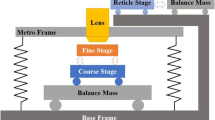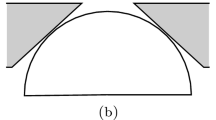Abstract
The ongoing increase of track density requirements of hard disk drives (HDDs) and decrease of flying height of sliders have brought along formidable challenges to suspension design. Conventional design processes are quite tedious and inefficient. This paper presents a HDD suspension design process by using topology optimization. An efficient structural topology optimization method, based on the second derivatives information, is proposed to generate structures which satisfy multiple design objectives including both compliance and eigenfrequencies. This topology optimization approach is successfully applied in the HDD suspension design. The design begins with a very simple initial draft, and the design objectives are defined to minimize the spring rate and maximize the resonant frequencies of first bending, first torsion and sway modes of a suspension. An optimal design concept can be generated from the topology optimization. Then the design is further tuned by using the shape optimization. Finally, an optimal suspension design for femto sliders with much better dynamic characteristics is presented.








Similar content being viewed by others
References
Bendsøe MP (1995) Optimization of structural topology, shape and material. Springer, Berlin Heidelberg, New York
Dennis JE, EI-Alem M, Maciel MC (1997) A global convergence theory for general trust-region-based algorithms for equality constrained optimization. SIAM J Optim 7:177–207
Fox RL, Kapoor MP (1968) Rates of change of eigenvalues and eigenvectors. AIAA J 14:1201–1205
Frank T, Neidthart W, Talke FE (2000) Optimization of a hard disk drive using finite element analysis. In: Symposium on interface tribology towards 100 Gbit/in2 and beyond, vol 10. pp11–17
Haftka RT, Gurdal Z (1992) Elements of structural optimization, 3rd edn. Kluwer Dordrecht, Boston London
Hsu YL, Hsu MS, Chen CT (2001) Interpreting results form topology optimization using density contours. Comp Struc 79:1049–1058
Lau GK, Du H, Pan L (2002) Optimal design of suspensions for high-density magnetic recording systems. IEEE Trans Magn 38(5):2165–2167
Svanbberg K (1987) The method of moving asymptotes—a new method for structural optimization. Int J Numer Meth Eng 24:359–373
Watanabe T, Ohwe T, Yoneoka S, Mizoshita Y (1997) An optimization method for precision positioning of pico-CAPS. IEEE Trans Magn 33(5):2644–2646
Xie YM, Steven GP (1997) Evolutionary structural optimization. Springer, Berlin Heidelberg, New York
Yang YP, Tu CC (1996) Multiobjective optimization of hard disk suspension assemblies: part I—structure design and sensitivity analysis. Comp Struc 59(4):757–770
Yu SK, Liu B (2003) Optimal suspension design for femto sliders. IEEE Trans Magn 39(5):2423–2425
Author information
Authors and Affiliations
Corresponding author
Rights and permissions
About this article
Cite this article
Yu, S.K., Liu, B. Topology optimization for femto suspension design. Microsyst Technol 11, 851–856 (2005). https://doi.org/10.1007/s00542-005-0546-0
Received:
Accepted:
Published:
Issue Date:
DOI: https://doi.org/10.1007/s00542-005-0546-0




